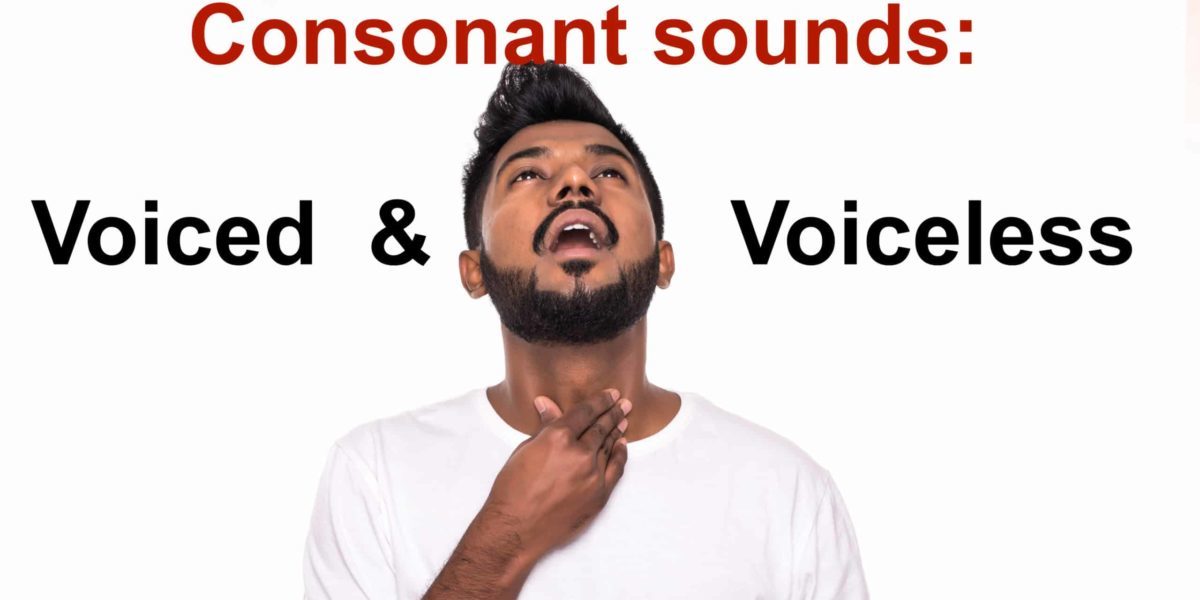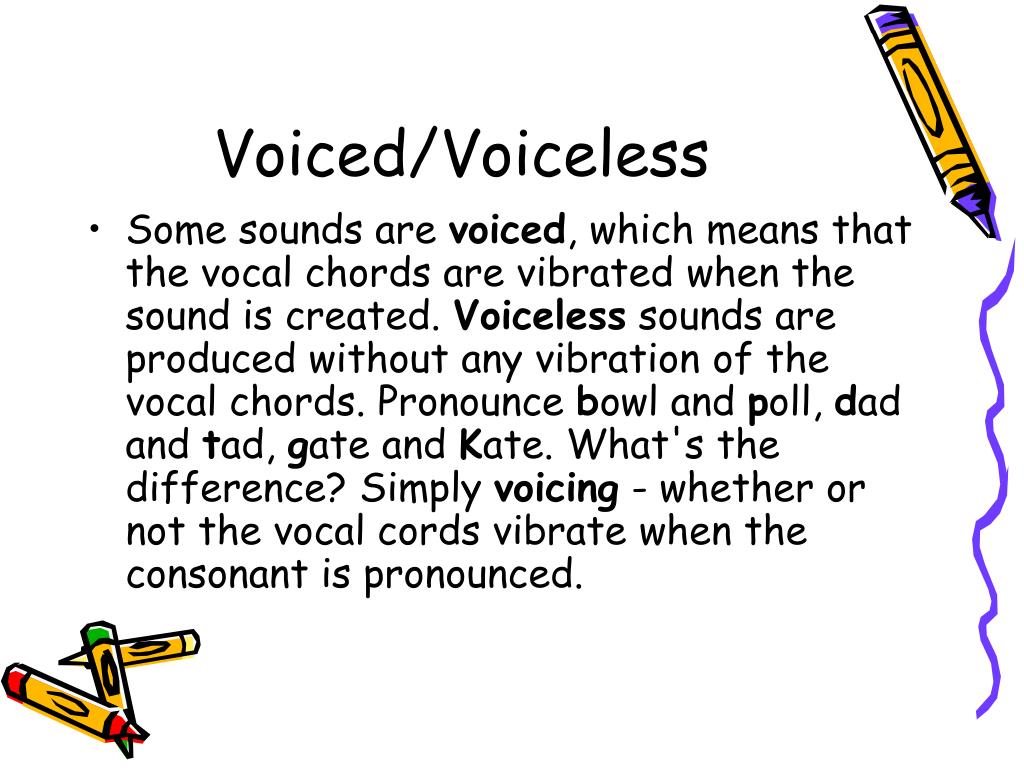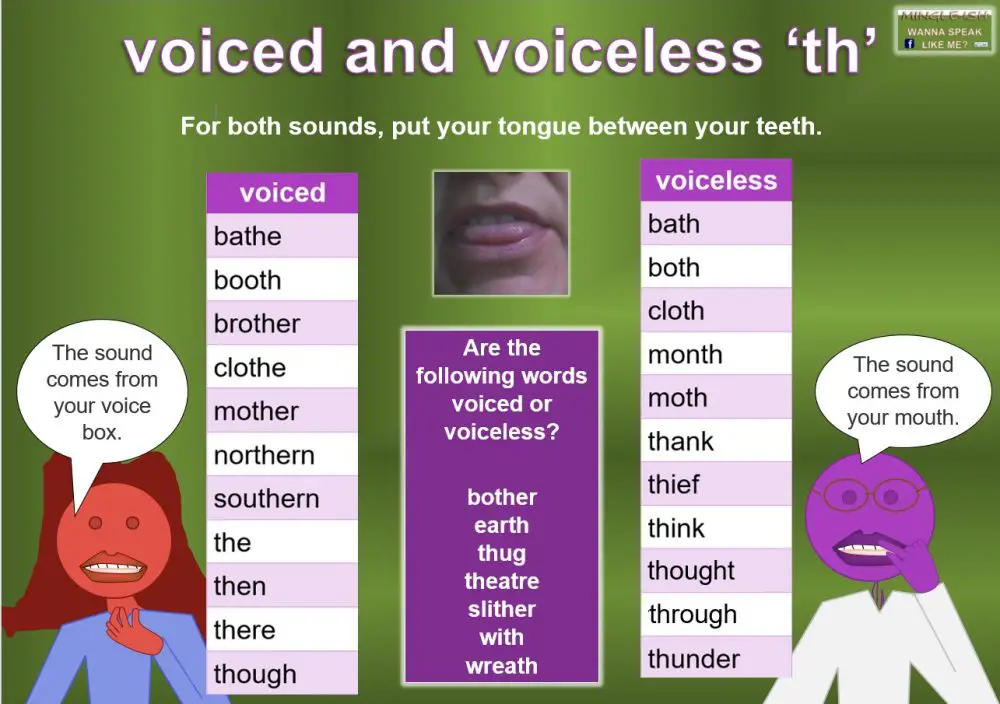
PPT Contrastive Grammar and Pronunciation PowerPoint Presentation
By Sabine Hobbel What are Consonants? English has 24 consonant sounds, and 21 consonants. When it comes to the pronunciation of these consonants, we divide them into 2 categories: voiced and voiceless consonants. Keep in mind, some consonant sounds are a combination of letters (e.g. ch or th).

ESL VOICED V AND UNVOICED F CONSONANT SOUND PAIR for ESL EASY NATIVE
Also, there are a number of allophonic differences that are still applied, such as vowel raising before voiceless (rapid has a higher, shorter vowel; rabid has a longer, lower vowel, and this is maintained under whispering). It would be interesting to see how whispering plays out in in tone languages, and in languages with a contrast between voiced stops vs. voiceless stops with negligible.

Voiced vs. Unvoiced Sounds What’s the difference? YouTube
Here are some more voiced and unvoiced pairs. All the sounds in the first column are voiced while the matching pairs in the second column are unvoiced. The last pair is an interesting one though. Most people make both sounds, /w/ and /hw/, voiced. Instead of /window/ and /hwale/, we typically make both of the initial sounds voiced: /window/ and.

Voiced & Unvoiced Sounds Voiced and Unvoiced Consonants
In American English, we have voiced and unvoiced sounds. All vowels are voiced. All diphthongs are voiced. Consonants can be either voiced or unvoiced. Unvoiced consonants are made just with air, no, uhh, sound from the vocal cords. For example, hh, sh, tt, pp. Voiced consonants do have voice in them, uhh, like: mm, bb, zh.

ESL VOICED 'TH' AND UNVOICED 'TH' CONSONANT SOUND PAIR for ESL EASY
Which Sounds Are Voiced? Which Sounds Are Unvoiced? Voiced consonants need the vocal chord vibrations to produce the sound. The voiced consonants are as follows: /b/, /d/, /g/, /j/, /l/, /m/, /n/, /r/, /v/, /w/, /y/, /z/

Phone clusters for vowels, voiced consonants, and unvoiced consonants
In the video about how humans produce speech, we felt the difference between voiced and voiceless sounds: for voiced consonants like [z] and [v], the vocal folds vibrate. For voiceless sounds like [s] and [f], the vocal folds are held apart to let air pass through.

💌 Voiced consonants. The 24 consonant sounds in English with examples
v t e Voice or voicing is a term used in phonetics and phonology to characterize speech sounds (usually consonants ). Speech sounds can be described as either voiceless (otherwise known as unvoiced) or voiced.

The Difference Between Voiced vs. Unvoiced Sounds in English YouTube
The only difference is the presence or absence of voice: /p/ is unvoiced (no vibration of vocal cords) and /b/ is voiced (vocal cords vibrate). Being aware of such differences is invaluable when teaching the pronunciation of -ed in the simple past tense and past participle of regular verbs.

Voiced S vs Unvoiced S 🤔 What's the difference? Learn with examples
The only difference is that P is an unvoiced sound (no vibration of the vocal cords) while B is a voiced sound (vocal cords vibrate). Put your hand on your throat as you say the pairs below to feel the difference. Note that the first pair of consonants in the table ( p, b) is produced at the front of the mouth.

PPT American Consonants PowerPoint Presentation, free download ID
All vowel sounds are voiced. The consonant phonemes, on the other hand, fall into different categories: stops, affricates, nasals, fricatives, liquids, and glides. Many phonemes are pairs that have the same mouth position but differ in that one is unvoiced while the other is voiced. The STOPS include these unvoiced/ voiced pairs:

Consonants Voiced vs. Unvoiced Can Do Kids Academy
What are voiced and unvoiced consonants? In this video I explain and demonstrate the difference between these two types of sounds in English.English has 44 d.

Classifications of Consonants English phonics, Speech language
Tell them that this is the main difference between the two sounds, because /z/ is voiced while /s/ is unvoiced. You could then give them a list of words and ask them to categorise the underlined consonant sound into these two categories. With /s/ and /z/, you might choose to include some third person singular verb and plural endings.

Voiced And Unvoiced Sounds Chart
There is one other consonant whose sound final

Pronunciation Voiced and Unvoiced Consonants YouTube
What is the difference between voiced consonants and unvoiced consonants? For voiced consonants, the vocal cords are engaged, making sound. For unvoiced consonants, the vocal cords are not making sound, there is just air passing through them. YouTube blocked? Click here to see the video. Video Text: Voiced and unvoiced consonants.

Voiced and voiceless (unvoiced) sounds Mingleish
@SHiNKiROU: this may be because the main acoustic difference between the voiced and voiceless stops are in a very concentrated part of the acoustic spectrum, and if one of your playback devices has difficulty transmitting that portion, you may lose the distinction. - Steven Sep 14, 2011 at 1:24 See voice onset time. - Paul Dexter

Difference between voiced and voiceless consonants
ThoughtCo. By Kenneth Beare Updated on June 26, 2019 Phoneticists (who study the sound of the human voice) divide consonants into two types: voiced and voiceless. Voiced consonants require the use of the vocal cords to produce their signature sounds; voiceless consonants do not.